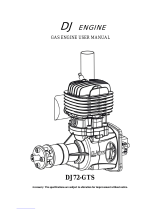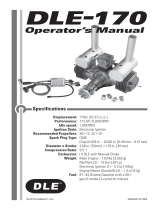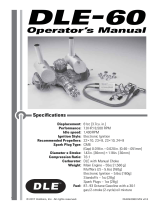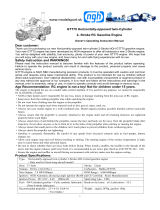Page is loading ...

Operator’s Manual for BT-64A
SPECIFICATIONS
Displacement: 3.85 cu in [63.1cc]
Horsepower: 5.7hp @ 9,000rpm
Ignition Style: CDI Automatic Timing
Module
™
RPM: 1,200 – 9,000rpm
Fuel: Gas/2-cycle engine oil
Weight w/muffler: 5.0 lbs [2.2kg]
Fuji-Imvac is not related to the original Fuji Engines sold by Mecoa.
Manufactured by FUJI-IMVAC INC.
YOKOHAMA, 235-0005 JAPAN
Worldwide Distributor (except Japan): Hobbico, Inc.
Champaign, IL 61826 USA
www.fuji-imvac.com
SAFETY TIPS AND WARNINGS
·
Always use a balanced spinner and a balanced prop. An unbalanced spinner
and prop combination will cause high levels of vibration and may cause the
propeller shaft to break.
·
Always use a lightweight spinner on your engine. Lightweight spinners are
considered to be those with a cone wall of 1mm or less. Heavy spinners could
cause the propeller shaft to break.
·
Securely tighten the spinner and prop on the engine to prevent it from being
thrown off the engine while running.
·
Never use a prop that has hit the ground. Even though it may look good from
the outside, it may be cracked on the inside which may cause it to disintegrate
while in use. Do not use a nicked, cracked or split propeller.
·
Keep foreign objects away from the propeller. Make sure that nothing can be
“sucked in” by the propeller. Never start the engine on loose gravel or sand.
·
Keep onlookers away from the running engine, specially small children.
·
Do not attempt to stop the engine by throwing anything into the path of the propeller.
·
Make sure the fuel line is well-secured to the engine and to the fuel tank so that
it won’t come off in flight.
™

·
Do not use silicone fuel line because it will be attacked by the fuel. Use vinyl or
neoprene rubber fuel line.
·
Always secure the fuel line away from the cylinder head. The engine’s heat can
damage the fuel line.
·
Never touch the engine after a run. The engine will be hot and it may burn you.
·
Before transporting your model, remove all the fuel from the fuel tank and fuel lines.
·
Always use high quality oil intended for 2-cycle engines.
·
Use only low-octane, alcohol-free gasoline. The carburetor diaphragm will
gradually deteriorate if you use gasoline with alcohol. You will need to replace
the diaphragm in about 80 hours of operation if you use gasoline with alcohol.
·
Muffler pressure to the fuel tank is not required.
·
Do not install your throttle servo or kill switch servo inside the engine compartment.
Doing so could cause radio interference. Install all electronic radio devices at least
12" [305mm] away from the engine. The throttle pushrod should be non-metallic.
·
In case the engine is not to be used for more than a month, drain the fuel tank
and remove any fuel from inside the carburetor. Do this by running the engine
at idle until it quits by running out of fuel. Keeping gasoline inside the carburetor
over an extended period of time will damage the diaphragm valve and clog
passages inside the carburetor.
·
Because the carburetor is more complicated than those used in glow engines,
keep the fuel clean by using a fuel filter. Use a filter intended to be used with
gasoline engines. Metal filters intended for glow engines are too coarse and will
not screen out finer particles. Always filter your fuel by using an appropriate filter
before putting it into the airplane’s fuel tank.
·
If you intend to run this engine on an engine stand, or on any other rigid mount,
use rubber mounts. The crankcase and other parts of the engine may crack if
you do not provide some kind of vibration absorption mechanism. A rubber
mount is not necessary if the engine is mounted on a model airplane.
·
Do not operate the engine in a closed room or where ventilation is not adequate.
·
Gasoline is extremely flammable. Keep it away from an open flame, excessive
heat or sources of sparks. Do not smoke near the engine or the fuel tank.
·
This engine was designed for use in a model aircraft. Do not attempt to use it
for any other purpose.
·
Always install a kill switch that can be operated manually and with the RC
transmitter.
AUTOMATIC IGNITION TIMING MODULE
The BT-64A engine ignition system is a combination of an electronic system and a
mechanical system. The working principle for the automatic ignition timing module
is that it gradually advances the ignition timing as the ignition pulses increase with
increasing engine rpm. The mixture is ignited when the piston is near top dead
center for idling and the timing is gradually advanced as the rpm increase.
PREPARING THE ENGINE
1. Check to see that all screws and bolts are tight. Check carefully for any cracks,
broken or missing parts. Tighten or replace before proceeding.
2

2. Install the prop shaft on the flywheel.
3. Install the spark plug in the cylinder head.
SPARK PLUG
The recommended spark plug is a Champion RCJ-6Y. To avoid improper operation
or possible engine damage, do not use any other type of spark plugs. The plug
gap should be 0.016" to 0.024" [0.4mm to 0.6mm]. If the plug gap is incorrect,
adjust it with a spark plug gapping tool, wash it with gasoline and allow it to dry
completely before you reinstall the plug in the engine.
PROPELLER
Always use a well-balanced, high-quality propeller.
The recommended propellers are:
22" x 10" High Performance Wood Prop
22" x 10" or 22" x 12" Carbon Prop
During our tests, our Fuji-Imvac BT-64A turned a Bolly 22" x 12" carbon prop at
7100 rpm. The engine was new with 60 minutes of breaking in. The test conditions
were: Temperature 59°F [15°C], Humidity 20%, elevation at sea level. Performance
may vary depending on atmospheric conditions.
INSTALLING THE FUJI-IMVAC BT-64A ON YOUR AIRPLANE
Note: The Fuji-Imvac BT-64A must be installed on a 1/2" [12mm] lite ply firewall
or on a 3/8" [9.5mm] birch ply firewall. The firewall must be securely glued to the
airplane. Use triangle stock and pin the firewall with hardwood dowels to reinforce
the firewall glue joints. Never install the Fuji-Imvac BT-64A onto a firewall thinner
than specified because it may fail due to the power of the engine.
1. Use the supplied template (on the back cover of this manual) to drill the engine
mounting bolt holes and the necessary clearance hole on the firewall.
3

2. Install the engine on the firewall using four 1/4" x 1-1/4" [6.4mm x 32mm] socket
head cap screws, four 1/4" [6.4mm] flat or lock washers and four 1/4" [6.4mm]
blind nuts. Use some threadlocking compound, such as Great Planes
®
Pro
™
Threadlocker (GPMR6060), on the screws.
3. Install the fuel tank in the airframe. Use only gasoline-safe fuel lines. One line
should go to the carburetor and the other is to be used as a vent. You can fill the
tank by using the carburetor line as fill line if you have access to it or install a third
line to be used as fill line.
4. Install a kill switch such as the Great Planes Gas Engine Ignition Switch
Harness (GPMG2150). Install the kill switch servo at least 12" [305mm] away from
the engine.
5. Install the throttle servo at least 12" [305mm] away from the engine. Make sure
that you get the carburetor’s full range of rotation with your servo travel.
6. Cut all necessary clearance and cooling holes in the cowl.
7. Make sure the cowl is secured to the airplane and that the spinner to cowl
clearance is at least 1/8" [3.2mm].
BEFORE OPERATION
1. Prepare only the amount of gasoline needed. Aged gasoline could damage the
engine and cause it to overheat.
2. If the engine was just run, make sure you allow enough time for it to cool down
before you run it again. Also, wipe any residue the engine may have thrown on the
airplane on the previous flight.
3. Check to see that there are no foreign objects in the path of the propeller.
Secure any loose articles of clothing so they cannot be drawn into the propeller.
4. Go through the safety tips and warnings at the beginning of this manual to
ensure a successful and safe engine run.
5. Fuel the airplane with the adequate gasoline mix.
BREAK IN THE ENGINE
·
To break in your Fuji-Imvac BT-64A you need to run the engine for about one
hour with a fuel mixture that has a 25:1 (4% oil) fuel/oil ratio.
·
Do not adjust the high-speed needle on the carburetor to break in the engine. If you
do so, carbon will accumulate in the spark plug and that will make ignition difficult.
·
Do not run at full power for extended periods of time while breaking in your engine.
·
Make sure that the engine has adequate cooling. While breaking in, the engine
may run at slightly higher temperatures.
·
If you wish to do so, you can break in your Fuji-Imvac BT-64A while flying your
airplane. Just make sure you observe all recommendations above.
RUNNING THE BT-64A ON YOUR AIRPLANE.
·
Once the engine is broken in, use 40:1 (2.5%) fuel/oil mix.
4

STARTING PROCEDURES
There are four recommended ways to start the Fuji-Imvac BT-64A:
A. Manual Starting:
Note: Use a thick glove to protect your hand while hand starting the Fuji-Imvac
BT-64A.
Propeller Rotation
Magnet
Pick Up
Position of the
magnets before flipping
the propeller when hand
starting the engine.
20˚
1. The propeller should be installed on the prop spacer so that it is comfortable
for you to flip it through compression. You also need to position it in a way
that when you flip the propeller, the magnets are 20° clockwise from the
magnet pick up. Use the sketch for reference.
2. Have someone help you hold the airplane while you start the engine.
3. Make sure the ignition is OFF, close the choke on the carburetor and open
the throttle slightly from the idle position.
4. Rotate the propeller slowly about 10 to 20 times (more in winter) until fuel begins
to be drawn into the carburetor. Another way to prime the engine is to rotate the
prop clockwise from bottom dead center to top dead center (compression) and
then counterclockwise back to bottom dead center repeatedly.
5. Switch the ignition to ON.
6. Flip the propeller clockwise several times briskly.
7. After you hear some initial firing sounds, move the lever to the OPEN position.
8. Set the throttle to high idle. Set the prop so that the magnets are 20°
clockwise from the magnet pick up when viewed from the front.
9. Flip the prop through compression rapidly. If this is done properly, the
engine will start between the first and the eighth flip of the prop. During our
testing, starting took an average of 3-4 flips.
10. After starting, let the engine idle for two to three minutes. Open and close
the throttle slowly until the engine runs smoothly at idle and at full throttle.
Acceleration should also be smooth.
11. If your engine does not start, repeat the procedure.
5

B. Electric Starter Use:
1. Make sure you use a good quality, lightweight aluminum spinner.
2. Have someone help you hold the airplane while you start it.
3. Make sure the ignition is OFF, close the choke plate on the carburetor and
open the throttle slightly from the idle position.
4. Use your electric starter to turn the engine over for several seconds.
5. Switch the ignition to ON and open the choke.
6. Set the throttle to high idle and use your electric starter to turn over the
engine until it starts.
7. After starting, let the engine idle for two to three minutes. Open and close
the throttle slowly until the engine runs smoothly at idle and at full throttle.
Acceleration should also be smooth.
8. If your engine does not start, repeat the procedure.
C. Spring Starting:
1. Have someone help you hold the airplane while you start it.
2. With the ignition OFF, close the choke plate on the carburetor and open the
throttle slightly from the idle position.
3. Rotate the propeller slowly about 10 to 20 times (more in winter) until fuel begins
to be drawn into the carburetor. Another way to prime the engine is to rotate the
prop clockwise from bottom dead center to top dead center (compression) and
then counterclockwise back to bottom dead center repeatedly.
4. Turn the ignition switch to the ON position.
5. Hold the propeller, turn it 360° clockwise (one full turn) and let it go (move
hand quickly away from the propeller arc).
6. After you hear some initial firing sounds, move the choke to the OPEN position.
7. Repeat Step 5 until your engine starts.
D. Onboard Electric Starter Use:
Follow the instructions supplied with the onboard electric starter.
ENGINE ADJUSTMENTS
Notes:
·
Always make high- and low-speed needle adjustments with the engine shut off.
Also make sure the ignition is OFF.
·
Adjust the needle marked “H” for high speed rpm. Adjust the needle marked “L”
for low speed rpm.
6

A. Normal high- and low-speed needle settings:
It is not necessary to change the needle settings if the engine runs smoothly.
Normally only the “H” needle will need adjustment from time to time and only by
a small amount.
H: Open the needle 3/4 of a turn from the closed position (±1/4 of a turn in winter).
L: Open the needle 1-3/8 turns from the closed position (±1/4 of a turn in winter).
Only adjust the high- and low-speed needle within the above range.
B. Idle adjustment:
Note: Do not confuse the idle screw with the low-speed needle “L”. The idle screw
physically adjusts how much the carburetor valve can close. The low-speed needle
“L” adjusts the gasoline to air mixture when the engine is running at low rpm. If your
engine appears to work correctly except that the low rpm are not as low as you want
them to be, then adjust the idle screw. If your engine behaves erratically at low rpm,
then adjust the low-speed needle “L”. When adjusting, turn the screw about 1/8 of a
turn each time. A dirty plug will make it difficult to adjust the idle rpm. Follow the
recommended procedures if any of the following happens:
Problem:
1. The engine hesitates when accelerated rapidly.
2. The rpm increases at idling.
3. The engine stops when the throttle is moved from high to low.
Solution:
Your low-speed needle “L” is too lean. Open it 1/8 turn and try again.
Problem:
The idle is not steady.
Solution:
Your low speed needle “L” valve is too rich. Close it 1/8 turn and try again.
7

C. High-Speed Adjustment:
The high-speed rpm and transition performance is adjusted with the high-speed
“H” needle valve. When adjusting, turn the screw about 1/8 of a turn each time.
The position of the “H” needle will vary according to air temperature and field
elevation. If your engine is running smoothly then do not adjust this needle valve.
Follow the recommended procedures if any of the following happens:
Problem:
1. Engine stops at full throttle.
2. Engine hesitates when accelerated rapidly.
3. The engine will not come up to full rpm at full throttle.
Solution:
Your high speed needle valve “H” is too lean. Open it 1/8 turn and try again.
Problem:
1. Your engine does not reach full rpm.
2. Carbon build-ups appear consistently on your spark plug.
Solution:
Your high speed needle valve “H” is too rich. Close it 1/8 turn and try again.
3-Year Limited Warranty For USA and Canada
Fuji-Imvac warrants this product to be free from defects in materials and workmanship for a period of
three (3) years from the date of purchase. During that period, Fuji-Imvac will, at its option repair or
replace without service charge any product deemed defective due to those causes. You will be
required to provide proof of purchase date (receipt or invoice).
·
This warranty does not cover damage caused by crash, abuse, misuse, alteration or accident.
Damage caused by customer disassembly, tampering, use of substandard fuel, use of incorrect
accessories (spark plug, prop, etc.) or any use of the engine for which it is not specifically intended
will automatically void the warranty of the engine. If there is damage resulting from these causes
within the stated warranty period, Fuji-Imvac will, at its option, repair or replace it for a service
charge not greater than 50% of the current retail list price. Be sure to include your daytime telephone
number and e-mail address in case we need to contact you about your repair.
·
Under no circumstances will the purchaser be entitled to consequential or incidental damages. This
warranty gives you specific legal rights and you may also have other rights, which vary from state
to state.
·
If you attempt to disassemble or repair this unit yourself, it may void the warranty.
For service on your Fuji-Imvac engine, either in or out of warranty, send it postpaid and insured to:
Hobby Services
3002 N. Apollo Dr., Suite #1
Champaign, IL 61822 USA
(217) 398-0007
www.hobbyservices.com
Along with your engine and proof of purchase date, please include a complete written explanation
detailing the problem(s). State your name and address clearly. For repairs not covered under warranty,
you must specify whether you wish the charges to be billed COD or if you wish to be notified of the
charges so you can send a check.
Outside USA and Canada, contact local importer for warranty information.
8

REPLACEMENT PARTS LIST (ENGINE)
9
Key # Part No. Description
1...........FJIG3060 .............................Ball Bearing
2...........FJIG3150 ...................Carburetor Gasket
3...........FJIG3220 ..........................Carb Insulator
4...........FJIG3390 ............................Clip (5.5mm)
5...........FJIG3460 ......................Coil Mount Plate
6...........FJIG3655 ..........................Collar (13mm)
7...........FJIG3720 ..........Box Wrench (17x19mm)
8...........FJIG3880 ...............Crankcase Assembly
9...........FJIG3970 ...................Crankcase Gasket
10.........FJIG4060 ............................... Crankshaft
11.........FJIG4330 .......................Cylinder Gasket
12.........FJIG4420 ................................... Cylinder
13.........FJIG4660 .......................... Engine Mount
14.........FJIG4740 .............. Flywheel Nut (12mm)
15.........FJIG4800 ................ Fuel Pipe (3x5x110)
16.........FJIG4830 ................ Fuel Pipe (3x5x280)
17.........FJIG4920 ................. Hex Wrench (4mm)
18.........FJIG5320 ..............................Ignition Coil
19.........FJIG5410 ............................. Inlet Gasket
20.........FJIG5700 .........................Magneto Rotor
21.........FJIG5910 ......................... Muffler Gasket
22.........FJIG6040 ..................................... Muffler
23.........FJIG6190 ..... Needle Bearing (2x8.8mm)
24.........FJIG6300 ....................................Oil Seal
25.........FJIG6400 ...................................... Piston
26.........FJIG6460 ................................ Piston Pin
27.........FJIG6530 ................. Piston Pin Retainer
28.........FJIG6560 ......................Piston Pin Collar
Key # Part No. Description
29.........FJIG6640 ..............................Piston Ring
30.........FJIG6870 ......................... Prop Flange B
31.........FJIG6900 .............................Pulse Fitting
32A ......FJIG7320 .......................... Shim (0.1mm)
32B ......FJIG7350 .......................... Shim (0.2mm)
32C ......FJIG7380 .......................... Shim (0.3mm)
32D ......FJIG7410 .......................... Shim (0.4mm)
33.........FJIG7470 ...............Spark Plug (RCJ-6Y)
34.........FJIG7500 .............. Spark Plug Cap Assy
35.........FJIG7660 ...Woodruff Key (3x13x4.5mm)
36.........FJIG7680 . Prop Flange A (1.5" [39.5mm])
37.........FJIG8085 ................ Propeller Fixing Bolt
38.........FJIG8231 ..................Hex Bolt (4x30mm)
39.........FJIG8290 .................... Hex Bolt (5x18/S)
40.........FJIG8300 .................... Hex Bolt (5x20/S)
41.........FJIG8305 .................... Hex Bolt (5x22/S)
42.........FJIG8310 ..................Hex Bolt (5x25WS)
43.........FJIG8350 ..................Hex Bolt (5x55mm)
44.........FJIG8390 ..............Hex Screw (5x12mm)
45.........FJIG8400 ..............Hex Screw (6x65mm)
46.........FJIG8520 ................. Hex Screw (5x12S)
47.........FJIG8640 .................Split Washer (4mm)
48.........FJIG8650 .................Split Washer (5mm)
49.........FJIG8645 ...............Small Washer (5mm)
50.........FJIG8740 .........................Washer (4mm)
51.........FJIG8750 .........................Washer (5mm)
52.........FJIG8765 .........................Washer (6mm)
53.........FJIG8770 .........................Washer (7mm)

REPLACEMENT PARTS LIST (CARBURETOR)
OPTIONAL ACCESSORIES
FJIG1050 ...... Spring Star ter
FJIG1186 ...... Onboard Electric Starter
FJIG4922 ...... Vibration proofing rubber (4 pieces/set)
FJIG7682 ...... Long Prop Spacer (2-3/8" [60mm])
FJIG8082 ...... Spinner Bolt Tru-Turn Adapter
10
Key # Part No. Description
FJIG3280 ............................... Carburetor
A ..........FJIG3000 ........................... Adjust Spring
B ..........FJIG3750 ........................... Control Lever
C ..........FJIG4590 .................... Diaphragm Cover
D ..........FJIG4650 .................. Diaphragm Gasket
E ..........FJIG5010 ................... High Adjust Screw
F ..........FJIG5100 .................................Hinge Pin
G ..........FJIG5130 ............... Hinge Pin Set Screw
H ..........FJIG5220 .....................Idle Adjust Screw
J...........FJIG5280 .................... Idle Adjust Spring
Key # Part No. Description
K ..........FJIG5460 ............................. Inlet Screen
L ..........FJIG5670 ....................Low Adjust Screw
M ..........FJIG5790 ................Metering Diaphragm
N ..........FJIG6240 ........................... Needle Valve
P ..........FJIG6990 ............. Pump Body Complete
Q .......... FJIG7050 .................... Pump Diaphragm
R ..........FJIG7110 ...........................Pump Gasket
S ..........FJIG7260 ................................ Set Screw
T ..........FJIG7290 ................................ Set Screw
U ..........FJIG7630 ............................ Valve Spring

11

Entire Contents © Copyright 2009 FJIZ1164 for FJIG0064 V2
Engine Mount Template for
Fuji-Imvac BT-64A Engine
/





